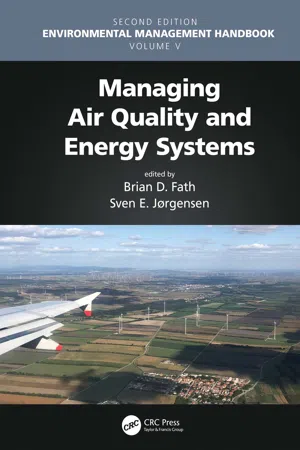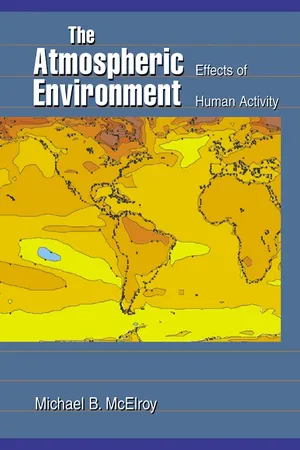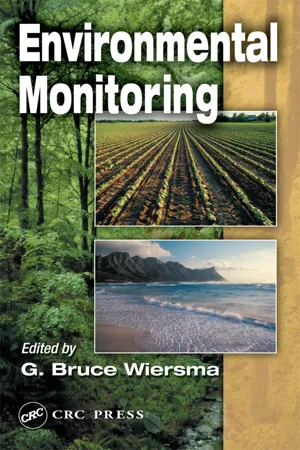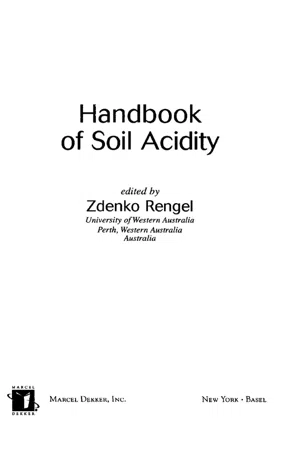Geography
Acid Precipitation
Acid precipitation, also known as acid rain, refers to rainfall or any form of precipitation that has a higher acidity than normal. This increased acidity is often caused by pollutants such as sulfur dioxide and nitrogen oxides released into the atmosphere from human activities, particularly the burning of fossil fuels. Acid precipitation can have detrimental effects on the environment, including harming aquatic ecosystems and damaging buildings and monuments.
Written by Perlego with AI-assistance
Related key terms
1 of 5
12 Key excerpts on "Acid Precipitation"
- eBook - PDF
- Kumar, A(Authors)
- 2021(Publication Date)
- Daya Publishing House(Publisher)
Chapter 12 Acid Rain Acid rain is precipitation containing higher than normal amounts of nitric and sulfuric acid. According to the EPA, acid rain can either occur by wet deposition or dry deposition, occurring when sulfur dioxide and nitrogen oxide react with the atmosphere. During wet deposition the gases react with water, oxygen and other chemicals. When this happens, various acidic compounds form, most commonly sulfuric and nitric acid. These acids are blown by the wind into areas with wet weather, where they fall in the form of rain or snow. If the acids are blown to areas with dry weather, they fall as dry deposition, clinging to dust or smoke, sticking to buildings and trees. The acid is then washed into the water system by rain. Acid rain forms from both natural and man-made sources. Volcanoes and decaying vegetation can form sulfur dioxide and nitrogen oxides. Emissions from burning fossil fuels also produce acid rain. According to the EPA, in the United States most of the sulfur dioxide and a quarter of nitrogen oxides “come from electric power generation that relies on burning fossil fuels, like coal.” Winds have been known to carry the acid rain into parts of Canada. Acid Rain Acid rain occurs when sulfur dioxide and nitrogen oxides are emitted into the atmosphere, undergo chemical transformations and are absorbed by water droplets in clouds. The droplets then fall to earth as rain, snow, or sleet. This can increase the acidity of the soil, and affect the chemical balance of lakes and streams. Acid rain is sometimes used more generally to include all forms of acid deposition – both wet deposition, where acidic gases and particles are removed by rain or other precipitation, and dry deposition removal of gases and particles to the Earth’s surface in the absence of precipitation. This ebook is exclusively for this university only. Cannot be resold/distributed. - eBook - PDF
Environmental Ecology
The Impacts of Pollution and Other Stresses on Ecosystem Structure and Function
- Bill Freedman(Author)
- 2013(Publication Date)
- Academic Press(Publisher)
4.1 INTRODUCTION The environmental impacts of the deposition of acidifying substances from the atmosphere, popu-larly known as acid rain, are currently a high-profile issue in both scientific and public forums. Only 15-20 years ago, acid rain research was es-sentially nonexistent, and few people were aware of or concerned about the potential effects of the acidification of natural ecosystems. This state of affairs changed quickly in the early 1970s, begin-ning with a catalytic conference held in 1970 in Stockholm: the United Nations Conference on the Human Environment. At this international scientific/environmental gathering, the Swedish government presented as a case study the results of an innovative research program, summarized in a report titled: Air Pollution across National Boundaries. The Impact on the Environment of Sulfur in Air and Precipitation [Royal Ministry of Foreign Affairs/Royal Ministry of Agriculture (RMFA/RMA), 1971]. Partly because of the atten-tion that this report focused on the anthropogenic acidification of ecosystems, over the next 5 years or so this field of investigation metamorphosed to 4 ACIDIFICATION a condition of vigorous and relatively well-funded scientific research, intense lobbying by nongovern-ment environmental organizations and by industry (of course, these groups lobbied in different direc-tions), and even some pollution control legislation by various levels of government. Because of these activities, acid rain impacts are now one of the bet-ter understood ways by which humans can degrade their environment. Equally important, acid rain is one of the most identifiable environmental prob-lems to the person-on-the-street, at least in north temperate industrialized countries. It is now known that the most important acidify-ing substances that are deposited from the atmo-sphere are weak solutions of sulfuric and nitric acids, which arrive in the form of acidic precipitation. - eBook - ePub
- Brian D. Fath, Brian D. Fath, Sven Erik Jorgensen(Authors)
- 2020(Publication Date)
- CRC Press(Publisher)
18, 1715–1724.9. Vermeulen, A.J. The acidic precipitation phenomenon. A study of this phenomenon and of a relationship between the acid content of precipitation and the emission of sulphur dioxide and nitrogen oxides in the Netherlands. In Polluted Rain; Toribara, T.Y., Miller, M.W., Morrow, P.E., Eds.; Plenum Press: New York, 1979; 7–60.10. Gibson, J.H. Evaluation of wet chemical deposition in north America. In Deposition Both Wet and Dry , Acid Precipitation Series; Hicks, B.B., Ed.; Butterworth Publishers: London, 1984; Vol. 4, 1–13.11. Keene, W.C.; Galloway, J.N.; Holden, J.D. Measurement of weak organic acidity in precipitation from remote areas of the world. J. Geophys. Res. 1983 , 88, 5122.12. Jacob, D.J.; Wofsy, S.C. Photochemistry of biogenic emissions over the Amazon forest. J. Geophys. Res. 1988 , 93, 1477–1486.13. Chameides, W.L.; Davis, D.D. Aqueous phase source for formic acid in clouds. Nature 1983 , 304, 427–429.14. Sanhueza, E.; Andreae, M.O. Emission of formic and acetic acids from tropical Savanna soils. Geophys. Res. Lett. 1991 , 18, 1707–1710.15. Rodhe, H.; Granat, L. An evaluation of sulfate in European precipitation 1955–1982. Atmos. Environ. 1984 , 18 , 2627–263.16. Overrein, L.; Seip, H.M.; Tollan, A. Acid Precipitation — Effects on Forest and Fish, Final report of the SNSF project 1972–1980. FR 19/80; Norwegian Institute for Water Research: Oslo, Norway, 1980.17. Bolin, B., Ed. The impact on the environment of sulphur in air and precipitation. Sweden’s National Report to the United Nations Conference on the Human Environment; Air Pollution Across Boundaries; Norstadt, Stockholm, 1971.18. Parashar, D.C.; Granat, L.; Kulshrestha, U.C.; Pillai, A.G.; Naik, M.S.; Momim, G.A.; Prakasa Rao, P.S.; Safai, P.D.; Khemani, L.T.; Naqvi, S.W.A.; Narverkar, P.V.; Thapa, K.B.; Rodhe, H. Chemical composition of precipitation in India and Nepal. A preliminary report on an Indo-Swedish project on atmospheric chemistry. Report CM 90; IMI, Stockholm University: Sweden, 1996. - eBook - PDF
Green Politics
An A-to-Z Guide
- Dustin Mulvaney, Dustin R. Mulvaney(Authors)
- 2010(Publication Date)
- SAGE Publications, Inc(Publisher)
A CID R AIN The average pH of rainwater is 5.6 (pH lev-els are based on the concentrations of hydro-gen ions with respect to pure water). Because water reacts with atmospheric carbon diox-ide to form carbonic acid, rain is typically slightly acidic. Acid rain (or acid deposition), however, refers to atmospheric precipitates with pH values below that of rainwater. Acid-causing contaminants may originate in locations far from the Acid Precipitation, and so this issue crosses boundaries, necessitat-ing political solutions. Acid deposition is linked to numerous negative environmental impacts, affecting both the natural and built environments. Soils become more acidified, rendering them less hospitable to certain plants. Higher acid levels in lakes lead to a reduction in fish popula-tions. Highly acidic precipitation exacerbates the weathering of many buildings, which is a particular problem with historical edifices. Limestone, for example, is weathered and eroded by acid rain. Although natural causes of acid rain exist, most acid deposition results from the by-products of anthropogenic actions, such as discharges from industrial activity. Natural causes such as volcanic eruptions, thunderstorm activity and lightning, and fire can, however, affect the atmosphere, leading to acidic precipitation. 1 A Trees damaged by acid rain and a bark beetle infestation loom above new growth in Germany’s Bavarian Forest near Mount Lusen. Source: iStockphoto.com 2 Acid Rain Chemically, sulfur and nitrogen oxides produced by industrial operations enter the atmosphere. Among the largest sources of these oxides is the generation of electrical power, in which coal and oil are burned; vehicular traffic also contributes significantly. The con-sumption of fossil fuels in both cases sends oxides into the atmosphere. Sulfurous emis-sions, largely from the production of electricity, combine with atmospheric water and oxygen to produce sulfuric acid (H 2 SO 4 ). - eBook - PDF
The Atmospheric Environment
Effects of Human Activity
- Michael B. Mcelroy(Author)
- 2021(Publication Date)
- Princeton University Press(Publisher)
Aluminum has a negative impact also on the ability of plants to absorb nutrients, such as phosphate. Acid Precipitation has been invoked to account for the decline of forests in parts of Europe and North America over the past several decades. The details of the impact, however, are un- clear. It is difficult to attribute changes observed in specific environments to any single influence. Changes in climate— drought, for example—can affect the health of a forest ecosystem over a particular period of time. Damage may be exasperated by outbreaks of insects or disease or by expo- sure to air pollutants, such as O 3 . It could be argued, indeed, that the impact of Acid Precipitation may be positive for some systems, under some circumstances. Acid rain can pro- vide an important source of nutrients N and S that might be otherwise in short supply. This chapter is motivated by the need to understand the factors influencing the chemistry of precipitation, especially the phenomenon of acid rain. We begin, in Section 18.1, with a more basic objective: to outline the approach used to describe solution in the liquid phase of a variety of atmos- pheric gases, without regard for their subsequent fate in the liquid phase. Specifically, our interest in this case is to iden- tify gases that are especially soluble in water, species for which solution in cloudwater can result in significant deple- tion of concentrations in the gaseous phase. We discuss the chemistry of CO 2 in Section 18.2, defining a reference value for the pH of water in equilibrium with atmospheric CO 2 . We elaborate mechanisms responsible for introduction of ni- tric and sulfuric acids to the condensed phase in Sections 18.3 and 18.4, respectively. We discuss neutralization of The Solubility of Atmospheric Gases in the Liquid Phase 265 acids in the presence of NH 3 in Section 18.5, whereas we present and discuss observational data on the chemistry of precipitation in Section 18.6. - Yeqiao Wang(Author)
- 2022(Publication Date)
- CRC Press(Publisher)
Other atmospheric substances from volcanic eruptions, forest fres, and similar natural phenomena also contribute to the natural sources of acidity in rain. Still, even with the enormous amounts of acids created annually by nature, normal rainfall is able to assimilate them to the point where they cause little, if any, known damage. However, large-scale human industrial activities have the potential of throwing of this acid balance, and converting natural and mildly acidic rain into precipitation with stronger acidity and far-reaching environmental efects. Tis is the root of the acid rain problem, which is not only of national but also international concern. Tis problem may have existed for more than 300 years starting at the time when the industrial revolution demanded a large scale burning of coal in which sulfur was a natural contami- nant. Several English scholars, such as Robert Boyle in the 17 th century and Robert A. Smith of the 19 th century, wrote about the acids in air and rain; though there was a lack of appreciation of the magnitude of the problem at that time. Individual studies of the acid rain phenomenon in North America started in the 1920s, but true appreciation of the problem came only in the 1970s. To address this problem, the U.S. Congress established the National Acid Precipitation Assessment Program (NAPAP) to study the causes and impacts of the acid deposition. Tis research established that acid rain does cause broad environmental and health efects; the pollution causing acid deposition can travel hundreds of miles, and electric power generation is mainly responsible for SO 2 ( ~65%) and DOI: 10.1201/9780429440984-3 11 12 Atmosphere and Climate NO x emissions ( ~30%). Subsequently, Congress created the Acid Rain Program under Title IV (Acid Deposition Control) of the 1990 Clean Air Act Amendments. Electric utilities are required to reduce their emissions of SO 2 and NO x signifcantly.- eBook - PDF
- G. Bruce Wiersma(Author)
- 2004(Publication Date)
- CRC Press(Publisher)
22.2 Acid Precipitation The early history of the Acid Precipitation problem is described by Likens 5 and Cowling, 6 and the more recent history by Clark et al. 7 and Sundqvist et al. 8 Acid Precipitation was identified as a potential problem in 19th century England by Smith, and its harmful effects were explored in the 1950s by Gorham. However, identifi- cation of Acid Precipitation as a major issue by the public did not become widespread until newspapers in Sweden began extensive coverage of an analysis of monitoring data by Oden in the late 1960s. Monitoring data from a network put into place in western Europe in the early 1950s showed that Acid Precipitation had increased substantially in both intensity and geographic extent, and that the increases could be correlated with monitoring data on emissions from stationary sources, some of which were hundreds of miles distant. This public attention led the Swedish gov- ernment to present a case study at the 1972 U.N. Stockholm Conference on the Human Environment, that led to the establishment of major government research programs in Europe and North America to more thoroughly analyze the problem. In the U.S., monitoring at an experimental watershed at Hubbard Brook in New York and at a few stations run by individual investigators around the country dem- onstrated that Acid Precipitation was already a widespread phenomenon in eastern North America in 1976, and that changes in the ratios of sulfuric and nitric acids could be correlated with monitoring data from emissions sources. Monitoring of lakes and streams in the U.S. and Canada also showed large numbers of acidified surface waters and declines in certain fish species. The National Acid Deposition Network (NADP) was established in the late 1970s (see Chapter 27 this book) to collect data nationwide. - eBook - PDF
The Biosphere, Problems and Solutions
Proceedings of the Miami International Symposium on the Biosphere, 23-24 April 1984, Miami Beach, Florida, U.S.A.
- T. N. Veziroglu(Author)
- 2011(Publication Date)
- Elsevier Science(Publisher)
The phenomenon of acidic precipitation may, i n the United States, be viewed i n terms of a controversy. It is the intent of t h i s review t o examine the various aspects of t h i s controversy and t o point out. the r e s u l t s of the most recent investigation and present t h i s information i n summary form. 2. The Controversy There are two major groups of thought concerning Acid Precipitation: Group I f e e l s that the problem of acid rain requires l e g i s l a t i v e a t t e n t i o n [ l l ] while Group I1 believes the s i t u a t i o n does not merit governmental a c t i o n [ l l ] . The position of the f i r s t group may be outlined a s follows[ll]: A. B. C. D. E. Acid Precipitation r e s u l t s largely from the combustion of f o s s i l fuels which releases oxides of N and S into the atmosphere. These oxides undergo transformation i n the atmosphere resulting i n the formation of HNO3 and H2SO4. These substances may be transported great distances. Once deposited through the vehicle of r a i n , snow, h a i l , m i s t , dew o r fog they cause damage t o vegetation, s o i l s and rocks, lakes and rivers, aquatic biota, statues, monuments, and buildings. In addition, t h i s s i t u a t i o n has accelerated since the mid-1950s. The areas most affected a r e southern and southwestern Scandinavia, Florida, California and the s t a t e s surrounding and including the 235 Adirondack region of the United States, and the region south of the Pre-Cambrian Shield i n Canada, mostly Ontario. Furthermore, t h i s group a s s e r t s t h a t the problem of acid rain has worsened since the 1950s and that the regions affected have steadily expanded. Proponents of t h i s position present data i l l u s t r a t i n g a mean decline of 0.5 pH u n i t s o r greater below the norm f o r rain (pH = 5.6), i n the regions affected. - eBook - ePub
- Zdenko Rengel(Author)
- 2003(Publication Date)
- CRC Press(Publisher)
4: Acid Inputs into the Soils from Acid Rain
Christine AlewellUniversity of Bayreuth, Bayreuth, Germany1 INTRODUCTION
Industrialized regions of the world have been confronted with the consequences of acidic deposition since the beginning of the 20th century. Today, there is substantial concern about the environmental impacts of air pollution on the local, regional, and global scale [1 ]. It has been shown that observed levels of various air pollutants can threaten human health, vegetation, wildlife, and soil biology; cause damage to materials; and change the chemistry of soils and waters.The term “acid rain” or “acid deposition,” which covers the wide range of physical, chemical, and biological processes involved in the issues of acidification, is defined here as the acid input to ecosystems and soils from the atmosphere originating in human activity (e.g., in fossil fuel burning). Although there is some question of whether any location on the earth is untouched by human activities in some way, the natural troposphere is usually referred to as the atmosphere over remote areas [2 ]. Thus, the anthropogenic pollution of the atmosphere, which is the origin of acid rain, always has to be assessed in comparison with the natural troposphere.Widespread regulatory action to curb air pollution was not taken until strong links were established between human health and pollutants in the mid-1900s. Until the 1950s, air pollution was emitted from relatively short smokestacks and had the most profound effects in areas immediately surrounding the source. In urban areas throughout the world, pollution events were both severe and frequent enough during this time period that they often led to human health problems [3 ]. One smog event in London in 1952 reportedly caused 4000 deaths [4 ]. In an effort to ameliorate the urban pollution situation, smokestack height was increased in North America and Europe between the 1950s and 1970s so that pollutants would disperse more widely. With the increased stack height, local pollution became regional pollution, and the era of the long-range transport of acid deposition had started. Acid rain problems have also extended to Asia because of a significant increase in atmospheric emissions resulting from high economic and population growth [5 - Joystu Dutta, Srijan Goswami, Abhijit Mitra, Joystu Dutta, Srijan Goswami, Abhijit Mitra(Authors)
- 2021(Publication Date)
- CRC Press(Publisher)
Acid rain primarily results from emissions of sulfur- (S) and nitrogen- (N) containing oxides from anthropogenic emissions, industrial exhausts, vehicular emissions as well as large-scale deforestation activities across the globe (Zhao et al., 2009 ; US Environmental Protection Agency (US EPA), 2018). Acid deposition is today one of the most pressing issues of the century and has the focus of the scientific community because of its potential impact on ecosystems contributing to water acidification, soil mineral depletion, plant and animal disappearance, forest damage, cultural heritage erosion, and other problems (Menz and Seip, 2004 ; Liu et al., 2019). Pollutants causing acidification play a crucial role in other environmental problems such as eutrophication, ground level ozone perturbation, and climate change (Manisalidis et al., 2020 ; Mohajan, 2018). In North America, Central Europe, and South-east Asia, acid rain has been a severe environmental issue for decades, and therefore has received much attention (Kuylenstierna et al., 2001 ; Zhao et al., 2009). Aquatic communities thriving in many siliceous mountain ranges of central Europe, such as the Black Forest, Harz, Erzgebirge, and Bohemian ranges, have faced consequences of acid rain and further signs of biological recovery have also been observed in these degraded ecosystems (Meybohm and Ulrich, 2007). Decreasing SO 2 emissions due to stringent environmental regulations in North America and Europe, as observed from 1990 to 2016, are responsible for such ecosystem recovery (U.S. Environmental Protection Agency (US EPA), 2018 ; European Monitoring and Evaluation Programme (EMEP), 2019)- eBook - PDF
Atmospheric Sulfur and Nitrogen Oxides
Eastern North American Source-Receptor Relationships
- George M. Hidy(Author)
- 2013(Publication Date)
- Academic Press(Publisher)
The vernacular term acid rain refers to the presence of acid-forming species in precipitation, especially SO4, NO^~, carbonate, and organic acid anions. In recent literature this term is synonymous with all forms of deposition of acid-forming material. Visibility Visibility is a measure of the ability of radiant energy to evoke visual sensation in an observer. Atmospheric constituents affect visible light transmission through the atmosphere by absorbing or scattering wave-lengths. Visibility impairment by suspended material depends on absorp-tion and scattering of light along a nearly horizontal path. Optical effects depend on the burden of suspended material or the product of ambient concentration and the path length of a light beam (Appendix B). In EN A visibility generally ranges from <10 to 40 km, in contrast to a natural (Rayleigh) limit from scattering by gas molecules of about 300 km. Thus, the receptor for source influence represents a volume of air extending horizontally to 40 km or more from an observer. Scale of Phenomena The spatial and temporal behavior of materials in the atmosphere can be classified according to scales as summarized in Table 1.2. The local TABLE 1.2 Spatial and Temporal Scales for Contaminant Episode Behavior in the Atmosphere Pollution class Meteorological class Horizontal spatial range (km) Temporal range (days) Comments Local Urban Regional Global Microscale Mesoscale Mesoscale synoptic scale Planetary scale 0-10 10-100 100-1000 1000 1 1-2 1-5 5-10 Recognized as classic pollution impact, basis for noncreative pollutant reactions Identified in the 1950s largely with reac-tive pollutant products, such as photo-chemical oxidants Recognized by problems related to haze and visibility degradation, acid rain, sor Source: Hidy et al., 1978. Surveyed extensively in relation to disper-sal of radionuclides from bomb tests - eBook - PDF
- James M. Beard(Author)
- 2016(Publication Date)
- CRC Press(Publisher)
These imbalances weaken the trees so much that they can easily be killed by other factors (insects, cold, viruses, bacteria, and fungi). A significant impact of Acid Precipitation on lower altitude forests has not been observed. Some disturbance in nutrients has been noted in some cases, but no clear deterioration in the health of the trees has been tied to these changes. So why are the more extreme effects observed at high elevation? The difference is related to what is known as acid fog . Because the highest peaks of a mountain often shoot up above the cloud level, they are often bathed in fog. For reasons that are too complex to go into here, fog tends to be much more acidic than rain under similar circumstances. The pH values will often go down to the vicinity of 2. Because many of the high-altitude trees are bathed in this acidic fog for longer periods of time than trees of lower alti-tude, one would expect the effects to be more severe. Effects on Human Health The effects of acid deposition on human health are almost totally related to the gases and particulate matter that are related to the production of the acids. Some of these gases are sulfur dioxide (SO 2 ), sulfur trioxide (SO 3 ), and nitrogen dioxide (NO 2 ). The health effects of these materials are discussed in Chapter 6. The Acid Precipitation itself has very little direct effect on human health. AIR POLLUTION AND THE LAW Attempts to control air pollution by the use of law go back at least as far as the 13th century, but the advent of the Industrial Revolution in the 18th century made air pollution a serious problem. Many attempts were made to control smoke by force of law in the 19th and early 20th centuries, but all to little avail. It was difficult to even agree on a clear definition of smoke.
Index pages curate the most relevant extracts from our library of academic textbooks. They’ve been created using an in-house natural language model (NLM), each adding context and meaning to key research topics.











